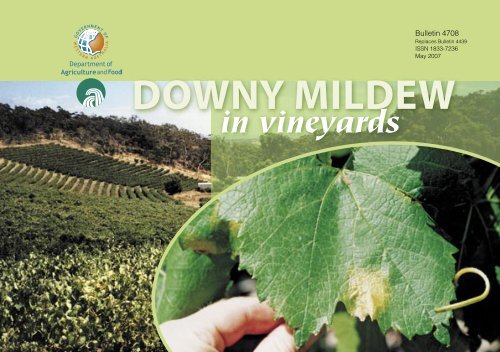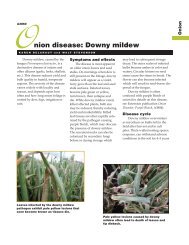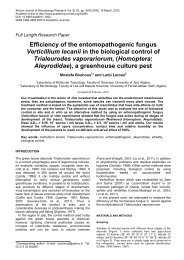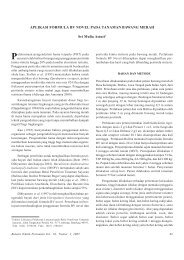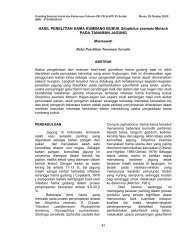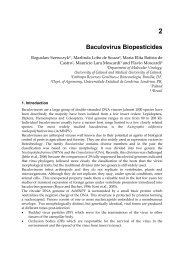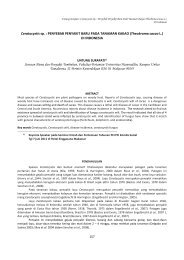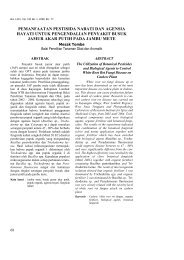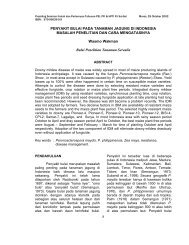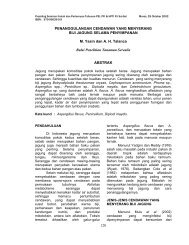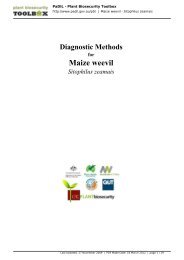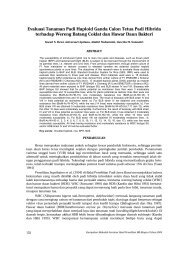Downy mildew in vineyards - Department of Agriculture and Food
Downy mildew in vineyards - Department of Agriculture and Food
Downy mildew in vineyards - Department of Agriculture and Food
Create successful ePaper yourself
Turn your PDF publications into a flip-book with our unique Google optimized e-Paper software.
Important Disclaimer:The Chief Executive Offi cer <strong>of</strong> the <strong>Department</strong> <strong>of</strong> <strong>Agriculture</strong> <strong>and</strong> <strong>Food</strong> <strong>and</strong> the State <strong>of</strong> Western Australia accept no liabilitywhatsoever by reason <strong>of</strong> negligence or otherwise aris<strong>in</strong>g from the use or release <strong>of</strong> this <strong>in</strong>formation or any part <strong>of</strong> it.In rely<strong>in</strong>g on or us<strong>in</strong>g this document or any advice or <strong>in</strong>formation expressly or impliedly conta<strong>in</strong>ed with<strong>in</strong> it, you accept all risks<strong>and</strong> responsibility for loss, <strong>in</strong>jury, damages, costs <strong>and</strong> other consequences <strong>of</strong> any k<strong>in</strong>d whatsoever result<strong>in</strong>g directly or <strong>in</strong>directlyto you or any other person from you do<strong>in</strong>g so. It is for you to obta<strong>in</strong> your own advice <strong>and</strong> conduct your own <strong>in</strong>vestigations <strong>and</strong>assessments <strong>of</strong> any proposals that you may be consider<strong>in</strong>g <strong>in</strong> light <strong>of</strong> your own circumstances.This material has been written for Western Australian conditions. Its availability does not imply suitability to other areas, <strong>and</strong> any<strong>in</strong>terpretation is the responsibility <strong>of</strong> the user.The product trade names <strong>in</strong> this publication are supplied on the underst<strong>and</strong><strong>in</strong>g that no preference between equivalent products is<strong>in</strong>tended <strong>and</strong> that the <strong>in</strong>clusion <strong>of</strong> a product does not imply endorsement by <strong>Department</strong> <strong>of</strong> <strong>Agriculture</strong> <strong>and</strong> <strong>Food</strong> Western Australiaover any other equivalent product from any other manufacturer. Any omission <strong>of</strong> a trade name is un<strong>in</strong>tentional.Always read the label.Users <strong>of</strong> agricultural (or veter<strong>in</strong>ary) chemical products must always read the label <strong>and</strong> any Permit before us<strong>in</strong>g the product, <strong>and</strong>strictly comply with the directions on the label or the conditions <strong>of</strong> any Permit. Users are not absolved from compliance with thedirections on the label or the conditions <strong>of</strong> the Permit by reason <strong>of</strong> any statement made or not made <strong>in</strong> this publication. Referto your w<strong>in</strong>ery, chemical re-seller, chemical company, Australian W<strong>in</strong>e Research Institute, Australian Pesticides <strong>and</strong> Veter<strong>in</strong>aryMedic<strong>in</strong>es Authority or <strong>Department</strong> <strong>of</strong> <strong>Agriculture</strong> <strong>and</strong> <strong>Food</strong> Western Australia if you are unsure about chemical registrations orchemical residues (especially if the grapes are be<strong>in</strong>g exported or are be<strong>in</strong>g used for export w<strong>in</strong>e).Information <strong>in</strong> this publication has been produced <strong>in</strong> association with non-<strong>Department</strong> <strong>of</strong> <strong>Agriculture</strong> <strong>and</strong> <strong>Food</strong> <strong>in</strong>dividuals, groups<strong>and</strong> organisations. The names <strong>of</strong> these signifi cant contributors have been provided at the beg<strong>in</strong>n<strong>in</strong>g <strong>of</strong> this publication.Recommendations were current at the time <strong>of</strong> preparation <strong>of</strong> this material (March 2007).© State <strong>of</strong> Western Australia, 2007
Bullet<strong>in</strong> 4708Replaces Bullet<strong>in</strong> 4439ISSN 1833-7236May 2007DOWNY MILDEW<strong>in</strong> v<strong>in</strong>eyardsDiana Fisher, Viticulture Development Officer, Andrew Taylor,Plant Pathologist, Col<strong>in</strong> Gordon, Senior Technical Officer,<strong>Department</strong> <strong>of</strong> <strong>Agriculture</strong> <strong>and</strong> <strong>Food</strong> Western Australia <strong>and</strong>Peter Magarey, Senior Plant Pathologist, <strong>Department</strong> <strong>of</strong>Primary Industries <strong>and</strong> Resources, South Australia.
PAGE 4DOWNY MILDEW IN VINEYARDSContentsIntroduction 5Symptoms .... 6Leaves .. 6Other causes <strong>of</strong> similar symptoms on leaves .............................................................................................................................8Shoots ... 8Infl orescences, bunches <strong>and</strong> berries .......................... 9Damage <strong>and</strong> loss ..................................................................................................... 10Varietal susceptibility ......................................................................................... 10Disease cycle .................................................................................................................. 10Overw<strong>in</strong>ter<strong>in</strong>g ..................................................................................................... 10Primary <strong>in</strong>fection (soil to v<strong>in</strong>e) ............................................. 10Oilspots .......................................................................................................................... 11Secondary <strong>in</strong>fection (leaf to: leaf, shoot, <strong>in</strong>fl orescence, berries, stalk) ...................................11Spread ............................................................................................................................ 13Monitor<strong>in</strong>g .............................................................................................................................. 13Management options ......................................................................................... 15Cultural ........................................................................................................................... 15Chemical ..................................................................................................................... 15Acknowledgements .............................................................................................. 18Further Read<strong>in</strong>g .......................................................................................................... 18
IntroductionDOWNY MILDEW IN VINEYARDS PAGE 5<strong>Downy</strong> <strong>mildew</strong>, caused by Plasmopara viticola, is a major fungal disease <strong>of</strong> grapev<strong>in</strong>esthat orig<strong>in</strong>ates from North America. This disease was fi rst detected <strong>in</strong> a commercialWestern Australian v<strong>in</strong>eyard <strong>in</strong> October 1998 <strong>and</strong> has s<strong>in</strong>ce been found <strong>in</strong> mostgrape grow<strong>in</strong>g areas with<strong>in</strong> the State. It is found <strong>in</strong> all other grape grow<strong>in</strong>g areas <strong>of</strong>Australia.Plasmopara viticola is specifi c to grapev<strong>in</strong>es (e.g. Vitis v<strong>in</strong>ifera), although not allVitis spp. are susceptible. The American rootstock species <strong>and</strong> hybrids are lesssusceptible or are resistant (refer to ‘Varietal susceptibility’). Other species <strong>of</strong> downy<strong>mildew</strong>, such as those found on cucurbits <strong>and</strong> roses, do not attack grapev<strong>in</strong>es.Although, weather conditions that favour the development<strong>and</strong> spread <strong>of</strong> grapev<strong>in</strong>e downy <strong>mildew</strong> alsomay encourage the development <strong>and</strong>spread <strong>of</strong> cucurbit <strong>and</strong> rosedowny <strong>mildew</strong>s.
PAGE 6DOWNY MILDEW IN VINEYARDSSymptoms<strong>Downy</strong> <strong>mildew</strong> attacks all green parts <strong>of</strong>the grapev<strong>in</strong>e.LeavesThe symptoms on leaves vary with leafage. On young leaves (i.e. spr<strong>in</strong>g),the disease will appear on the uppersurface as small yellow spots referredto as oilspots; they are about 10 mmdiameter <strong>of</strong>ten with a chocolate halo.These spots tend to grow to about 50mm diameter as they mature <strong>and</strong> thehalo fades. As these spots enlarge theymay appear to cover most <strong>of</strong> the leaf,especially if there is more than one spoton the leaf.<strong>Downy</strong> <strong>mildew</strong> oilspot.Rapidly grow<strong>in</strong>g oilspots <strong>of</strong>ten merge,<strong>in</strong>fect<strong>in</strong>g much <strong>of</strong> the leaf. Often downy<strong>mildew</strong> is not detected until the diseasespreads <strong>and</strong> more oilspots are visible (notethe white areas on the leaves are spraydeposits).<strong>Downy</strong> <strong>mildew</strong> oilspots are <strong>of</strong>ten surroundedby a chocolate halo that fades as theoilspots grow (note the white areas on theleaves are spray deposits).
DOWNY MILDEW IN VINEYARDS PAGE 7After suitable warm humid nights, adense, raised, white cottony growthdevelops on the underside <strong>of</strong> theyellow oilspots. This growth is commonlyreferred to as ‘white down’. As the spotsage naturally, or after a sporulation event,or after hot weather, their centres dry out<strong>and</strong> become a reddish brown leav<strong>in</strong>g anouter r<strong>in</strong>g <strong>of</strong> yellow. The fungus <strong>in</strong> thisyellow r<strong>in</strong>g rema<strong>in</strong>s active <strong>and</strong> givenfavourable conditions at night, canproduce a r<strong>in</strong>g <strong>of</strong> ‘white down’ on thisouter active edge..After favourable conditions this outer activeyellow r<strong>in</strong>g can produce ‘white down’.White down (spores) develop beneathoilspots after a suitably warm, humid night.The centre <strong>of</strong> the oilspots dry out <strong>and</strong>become a reddish brown leav<strong>in</strong>g an outerr<strong>in</strong>g <strong>of</strong> yellow.
PAGE 8DOWNY MILDEW IN VINEYARDSInfection on mature leaves will be yellowbrown<strong>and</strong> rema<strong>in</strong> small, confi ned by thefi nest <strong>of</strong> ve<strong>in</strong>s.White down (spores) will also developbeneath <strong>in</strong>fections on mature leaves after asuitably warm, humid night.Later <strong>in</strong> the grow<strong>in</strong>g season (i.e. latesummer <strong>and</strong> autumn) on mature leaves,leaf <strong>in</strong>fections will appear as small,angular, yellow spots that are limited<strong>in</strong> growth by the ve<strong>in</strong>s. These form atapestry-like (mosaic) pattern <strong>of</strong> spotsthat soon turn reddish brown. Defoliationcan occur <strong>in</strong> severely affected v<strong>in</strong>es.Other causes <strong>of</strong> similar symptomson leavesYoung downy <strong>mildew</strong> <strong>in</strong>fections may beconfused with powdery <strong>mildew</strong>, causedby Erysiphe necator. <strong>Downy</strong> <strong>mildew</strong>spots are oily with a chocolate halo <strong>and</strong>develop ‘white down’ on the underside<strong>of</strong> the leaf. Powdery <strong>mildew</strong> spots are<strong>of</strong>ten smaller <strong>and</strong> yellow-green whichthen develop a th<strong>in</strong> layer <strong>of</strong> ash-greypowdery spores that may eventuallycover both sides <strong>of</strong> the leaf (refer toBullet<strong>in</strong> 4575 Powdery Mildew <strong>in</strong> W<strong>in</strong>eGrapes <strong>in</strong> Western Australia).Yellow spots on leaves may also be dueto spray drift damage from herbicidessuch as paraquat (e.g. Spray.Seed ® )or suck<strong>in</strong>g <strong>in</strong>sect damage. Paraquatdamage is dist<strong>in</strong>guishable from downy<strong>mildew</strong> as it does not grow <strong>and</strong> it tendsto develop a small brown spot <strong>in</strong> thecentre <strong>of</strong> the yellow area. Also, neitherform <strong>of</strong> damage will produce white downon the underside <strong>of</strong> the spots after thebag test (see ‘Monitor<strong>in</strong>g’).White growth on the underside <strong>of</strong> a leafmay also be due to grape leaf blistermite damage. This white growth isdist<strong>in</strong>guishable from downy <strong>mildew</strong> as itforms with<strong>in</strong> blister-like green galls thatbulge on the upper side <strong>of</strong> the leaf.White fungal growth on a leaf may alsobe due to other fungi such as Penicillium,Aspergillus or Rhizopus. These fungal<strong>in</strong>fections will eventually change togreen, blue, black or brown.ShootsInfection on young shoots, stems <strong>and</strong>tendrils are seen as oily brown areas.These oily patches may spread <strong>in</strong>to leafstalks, which turn brown <strong>and</strong> may die.After suitable warm humid nights theseoily patches may also sporulate <strong>and</strong> becovered with white down.
DOWNY MILDEW IN VINEYARDS PAGE 9Inflorescences, bunches <strong>and</strong> berriesInfection on <strong>in</strong>florescences, youngberries <strong>and</strong> bunches are seen as oilybrown areas. After suitable warm humidnights they may be covered with whitedown. Infected <strong>in</strong>florescences <strong>and</strong> youngbunches rapidly turn brown <strong>and</strong> wither.Infected young berries stop grow<strong>in</strong>g,harden <strong>and</strong> may later develop a purplehue. They then turn a dark brown, shrivel<strong>and</strong> fall from bunches.Berries become resistant to <strong>in</strong>fectionwhen they are about pea size (around5-6 mm diameter). However, they maystill be killed if the berry or bunch stemsbecome <strong>in</strong>fected. They may also sunburn<strong>and</strong> fail to ripen if defoliation occurs fromleaf <strong>in</strong>fection.White spores may develop on<strong>in</strong>fl orescences after <strong>in</strong>fection.Infection near fl ower<strong>in</strong>g can kill the buncheswhich then turn brown.
PAGE 10DOWNY MILDEW IN VINEYARDSDamage <strong>and</strong> lossSevere <strong>in</strong>fection will cause leaves to fallprematurely, reduc<strong>in</strong>g yield <strong>and</strong> berrysugar content <strong>and</strong> will expose rema<strong>in</strong><strong>in</strong>gbunches to sunburn. Total crop loss mayoccur if severe <strong>in</strong>fection is not managed,especially near flower<strong>in</strong>g. Severe leaf fallalso can cause yield loss <strong>in</strong> the follow<strong>in</strong>gseason due to the <strong>in</strong>ability <strong>of</strong> the v<strong>in</strong>e tostore reserves.Varietal susceptibilityAll varieties <strong>of</strong> Vitis v<strong>in</strong>ifera aresusceptible to downy <strong>mildew</strong> <strong>in</strong>fection.Vitis v<strong>in</strong>ifera hybrids, V. aestivalis <strong>and</strong> V.lambrusca are less susceptible while V.rupestris, V. cordifolia <strong>and</strong> V. rotundifoliaare generally resistant.Disease cycle<strong>Downy</strong> <strong>mildew</strong> is an obligate parasite(mean<strong>in</strong>g it requires a liv<strong>in</strong>g host) <strong>and</strong>therefore it grows on all green parts <strong>of</strong> thev<strong>in</strong>e. However, there is one overw<strong>in</strong>ter<strong>in</strong>gstage <strong>of</strong> downy <strong>mildew</strong> development thatis not found on green tissue.Overw<strong>in</strong>ter<strong>in</strong>gOospores (rest<strong>in</strong>g bodies) are formed <strong>in</strong>late summer or autumn from the fungalgrowth with<strong>in</strong> leaves, shoots or berries.These rest<strong>in</strong>g bodies fall to the groundwhen leaves <strong>and</strong> bunch parts fall <strong>in</strong>autumn. There they overw<strong>in</strong>ter <strong>in</strong> <strong>in</strong>fectedleaves <strong>and</strong> litter <strong>in</strong> the soil for 3 to 5 years(<strong>and</strong> possibly up to 10 years).Oospores are the sexual structures <strong>of</strong>downy <strong>mildew</strong>. An oospore has a thickwall that makes it less susceptibleto fungicides <strong>and</strong> adverse weatherconditions, such as exposure to thesun, than zoospores or sporangia (seebelow).Primary <strong>in</strong>fection (soil to v<strong>in</strong>e)The 10:10:24 ‘rule <strong>of</strong> thumb’ refers tothe conditions required for primary (first)<strong>in</strong>fection to occur. At least 10 mm ra<strong>in</strong>fall(<strong>and</strong> irrigation) is required while thetemperature is 10°C or more over a 24-hour period. Not all 10:10:24 conditionsare suitable for a primary <strong>in</strong>fection butthis ‘rule <strong>of</strong> thumb’ provides a goodguide to monitor for favourable primary<strong>in</strong>fection conditions.10:10:24 ‘rule <strong>of</strong> thumb’At least 10 mm ra<strong>in</strong>fall(<strong>and</strong> irrigation);10°C or more;over a 24 hour periodMore specifically the conditionsrequired for oospores to germ<strong>in</strong>ate are:• soil needs to be wet for at least 16hours• usually achieved by 3-5 mm ra<strong>in</strong>fall(<strong>and</strong>/or irrigation).• temperature also needs to rema<strong>in</strong>above 10°C.The germ<strong>in</strong>ated oospores then releasezoospores (that swim <strong>in</strong> free water)which then need to be splashed by ra<strong>in</strong>or irrigation to the v<strong>in</strong>e canopy before theend <strong>of</strong> the 24 hour period. This process
DOWNY MILDEW IN VINEYARDS PAGE 11usually requires another 3-5 mm <strong>of</strong> ra<strong>in</strong>(<strong>and</strong>/or irrigation) to ensure suffi cientsplash <strong>and</strong> leaf wetness for <strong>in</strong>fection onthe underside <strong>of</strong> the leaves. For this, thefoliage must rema<strong>in</strong> wet for at least 2-3hours at 20°C (or 4-5 hours at 10°C) forthe spores to <strong>in</strong>fect the leaf <strong>and</strong> completethe primary <strong>in</strong>fection cycle.Irrigation alone is not normally enoughto <strong>in</strong>duce a primary <strong>in</strong>fection. However,ra<strong>in</strong>fall <strong>and</strong> irrigation comb<strong>in</strong>ed can besuffi cient for this to occur.OilspotsThe zoospores released dur<strong>in</strong>g primary<strong>in</strong>fection that establish on the underside<strong>of</strong> the leaf beg<strong>in</strong> to grow fungal hyphae.These hyphae grow <strong>in</strong>side the leaves t<strong>of</strong>orm oilspots that appear 5 to 17 days (butmore <strong>of</strong>ten 5 to 10 days) after <strong>in</strong>fectionhas occurred. The development <strong>of</strong>oilspots is quickest <strong>in</strong> warm weather (18-27°C). At warmer or cooler temperaturesthe <strong>in</strong>cubation period is longer.Primary <strong>in</strong>fection levels are usuallylow with only 1-3 oilspots develop<strong>in</strong>gper 50 m <strong>of</strong> v<strong>in</strong>e row. Hence, primary<strong>in</strong>fections are very diffi cult to fi nd <strong>and</strong>do not themselves cause crop loss.However they are very important <strong>in</strong> thatthey allow the disease to spread rapidlyif secondary <strong>in</strong>fection events occur.Secondary <strong>in</strong>fection (leaf to: leaf,shoot, <strong>in</strong>florescence, berries, stalk)At least 98% humidity;13°C or more;at least 4 hours darkness;leaf wetness 2-3 hours near dawn<strong>Downy</strong> <strong>mildew</strong> (Plasmopara viticola)Figure 1. <strong>Downy</strong> <strong>mildew</strong> ‘white down’ underthe microscope. (Diagram courtesy RosPilbeam, formerly Horticulture Pathologist,<strong>Department</strong> <strong>of</strong> <strong>Agriculture</strong> <strong>and</strong> <strong>Food</strong>).Active oilspots need to be present beforesecondary <strong>in</strong>fections can occur. Theseoilspots (<strong>and</strong> surfaces <strong>of</strong> other diseasedtissue) produce sporangia (seen as whitedown) on suitable warm wet nights.Sporulation requires at least 4 hours <strong>of</strong>darkness to develop, dur<strong>in</strong>g which timethe temperature is 13°C or more <strong>and</strong>humidity is 98% or more.To then cause <strong>in</strong>fection the foliagemust also be wet for at least 2-3 hoursonce sporulation has occurred. Thewet foliage can be the result <strong>of</strong> ra<strong>in</strong>fall,overhead irrigation or occasionally fromheavy dew.Secondary <strong>in</strong>fections can occur anytimedur<strong>in</strong>g the grow<strong>in</strong>g season wheneveroilspots are present <strong>and</strong> conditions arefavourable.Sporangia are the asexual structures <strong>of</strong>downy <strong>mildew</strong>. Sporangia are producedon t<strong>in</strong>y treelike structures known assporangiophores (see Figure 1). A s<strong>in</strong>glesporangium can <strong>in</strong> turn produce between1 to 10 zoospores. Zoospores are ableto move (swim) through water but arespread ma<strong>in</strong>ly by w<strong>in</strong>d <strong>and</strong> ra<strong>in</strong>splash.
PAGE 12DOWNY MILDEW IN VINEYARDSFigure 2. The life cycle <strong>of</strong> downy <strong>mildew</strong>(reproduced with permission from PeterMagarey).
DOWNY MILDEW IN VINEYARDS PAGE 13SpreadPrimary <strong>in</strong>fections beg<strong>in</strong> the diseasecycle by provid<strong>in</strong>g a source <strong>of</strong>oilspots.Secondary <strong>in</strong>fections produce sporesthat can be spread by w<strong>in</strong>d <strong>and</strong> ra<strong>in</strong>to establish new <strong>in</strong>fection sites.Secondary <strong>in</strong>fections are the majorsource <strong>of</strong> disease spread.Monitor<strong>in</strong>gGood management <strong>of</strong> downy <strong>mildew</strong>is dependent on good monitor<strong>in</strong>g <strong>of</strong>favourable weather conditions for primary<strong>and</strong> secondary <strong>in</strong>fection events <strong>and</strong> <strong>of</strong>disease progress <strong>in</strong> the v<strong>in</strong>eyard.Automatic weather stations can beused for monitor<strong>in</strong>g <strong>and</strong> predict<strong>in</strong>gweather events. Weather stations collect<strong>in</strong>formation on temperature, ra<strong>in</strong>fall,leaf wetness <strong>and</strong> humidity (suitablefor downy <strong>mildew</strong>) <strong>and</strong> process thedata for the likelihood <strong>of</strong> a primary orsecondary <strong>in</strong>fection event (e.g. Ausvit).Alternatively a maximum/m<strong>in</strong>imumthermometer <strong>and</strong> a ra<strong>in</strong> gauge can beused as a guide.Monitor<strong>in</strong>g <strong>in</strong> the v<strong>in</strong>eyard is importantto confirm possible <strong>in</strong>fections fromweather events. Physical exam<strong>in</strong>ationcan confi rm whether a pre-<strong>in</strong>fection orpost-<strong>in</strong>fection fungicide is required <strong>and</strong>will also <strong>in</strong>dicate if spray coverage waseffective after an event.Monitor<strong>in</strong>g <strong>in</strong> the v<strong>in</strong>eyard shouldoccur every 7 - 14 days when weatherconditions are favourable from 3 to 4weeks after budburst (i.e. when shootsare approximately 10 cm long).Some general guidel<strong>in</strong>es on v<strong>in</strong>eyardmonitor<strong>in</strong>g <strong>in</strong>clude:• V<strong>in</strong>es to be monitored should berepresentative <strong>of</strong> the block be<strong>in</strong>gassessed.• Monitor for possible source areas<strong>of</strong> downy <strong>mildew</strong> <strong>in</strong>fection such aswetter more sheltered parts <strong>of</strong> thev<strong>in</strong>eyard (e.g. near w<strong>in</strong>dbreaks <strong>and</strong>sheds), v<strong>in</strong>es with dense canopiesor areas that have previously been<strong>in</strong>fected.• Inspect both sides <strong>of</strong> 200 v<strong>in</strong>es byscann<strong>in</strong>g the foliage between midmorn<strong>in</strong>g<strong>and</strong> mid-afternoon.• Spend about 30 seconds per v<strong>in</strong>e.Less time will be required early <strong>in</strong>the season when v<strong>in</strong>e canopies aresmall.• Focus on the canopy near theground <strong>in</strong> lower ly<strong>in</strong>g areas wherethe soil may rema<strong>in</strong> wet for extendedperiods.• The disease is diffi cult to detect <strong>in</strong>dense shaded canopies. The foliagemay need to be parted to scan the<strong>in</strong>ner leaves.
PAGE 14DOWNY MILDEW IN VINEYARDS• Use a h<strong>and</strong> lens to check suspectspots on leaves for evidence <strong>of</strong> thefungus.• Take samples <strong>of</strong> suspect leaves <strong>and</strong>bunches <strong>and</strong> conduct a bag test(see below).• Tag suspect sample sites so theymay become the reference po<strong>in</strong>ts ifthe sample is confi rmed positive.Monitor<strong>in</strong>g for downy <strong>mildew</strong> can becomb<strong>in</strong>ed with monitor<strong>in</strong>g for other pests(e.g. diseases <strong>and</strong> <strong>in</strong>sects).Note: Other fungi may <strong>in</strong>fect leaves <strong>and</strong>bunches. <strong>Downy</strong> <strong>mildew</strong> spores are white<strong>and</strong> raised. Powdery <strong>mildew</strong> spores areash-grey <strong>and</strong> are a uniform th<strong>in</strong> layer.Botrytis spores are cream to grey-brown.Penicillium, Aspergillus or Rhizopus arewhite <strong>and</strong> raised but change to green,blue, black or brown. If there is anyuncerta<strong>in</strong>ty suspect samples may besubmitted to a pathology laboratory forconfi rmation.AGWEST Plant Laboratories<strong>Department</strong> <strong>of</strong> <strong>Agriculture</strong> <strong>and</strong> <strong>Food</strong>Western AustraliaLocked Bag No. 4Bentley Delivery Centre WA 6983Ph: (08) 9368 3721Fax: (08) 9474 2658Oilspots that have already developed‘white down’ on their underside (whetherthis fungal growth is fresh or old) maynot develop any more ‘white down’ evenafter a bag test is conducted.Bag testThe bag test is used to <strong>in</strong>dicate active downy <strong>mildew</strong>.• Pour clean water <strong>in</strong>to an empty sealable plastic bag; shake the contents,then empty the bag leav<strong>in</strong>g it lightly moistened.• Seal fresh, suspect leaves or bunches <strong>in</strong> the bag overnight <strong>in</strong> the dark at20°C to 25°C, but at least greater than 13°C.• A kitchen cupboard is usually ideal. It is best to place the leaves fac<strong>in</strong>gdownwards <strong>in</strong> the bag. Do not place leaves or bunches on top <strong>of</strong> eachother.• Next morn<strong>in</strong>g, fresh white down will have developed on young bunches oron the undersides <strong>of</strong> oil spots if downy <strong>mildew</strong> is present <strong>and</strong> active.
Management optionsCulturalOospores may spread from propertyto property <strong>and</strong> region to region by themovement <strong>of</strong> <strong>in</strong>fected leaves <strong>and</strong> litter<strong>in</strong> the soil or on v<strong>in</strong>es late summer <strong>and</strong>autumn. Avoid distribution <strong>of</strong> <strong>in</strong>fectedsoil <strong>and</strong> plant matter by equipment <strong>and</strong>mach<strong>in</strong>ery (e.g. mechanical harvesters,leaf pluckers, trimmers <strong>and</strong> utilities), bysoil still adhered to rootl<strong>in</strong>gs, or by pottedv<strong>in</strong>es from nurseries.Sporangia may spread across propertyboundaries by w<strong>in</strong>d. It is very diffi cult toprevent the spread <strong>of</strong> these spores. Itis believed that sporangia rarely spreadmore than 200 m by w<strong>in</strong>d.Canopy management practices thatencourage air movement will help todry out leaves <strong>and</strong> improve sunlight<strong>and</strong> spray penetration. This will helpto prevent <strong>in</strong>fection. Such practices<strong>in</strong>clude:• lower plant<strong>in</strong>g density• trellis<strong>in</strong>g <strong>and</strong> prun<strong>in</strong>g to open thecanopy• shoot tra<strong>in</strong><strong>in</strong>g to open the canopy• v<strong>in</strong>e trimm<strong>in</strong>g <strong>and</strong> hedg<strong>in</strong>g• lateral shoot th<strong>in</strong>n<strong>in</strong>g• leaf pluck<strong>in</strong>g.Vegetative growth may also bemanaged by the selection <strong>of</strong> appropriaterootstocks prior to plant<strong>in</strong>g <strong>and</strong> by carefulapplication <strong>of</strong> fertilisers (e.g. nitrogen).Excessive growth leads to denseshaded canopies that may encouragethe development <strong>of</strong> downy <strong>mildew</strong>.ChemicalPre-<strong>in</strong>fection fungicides (appliedas close as possible but prior to an<strong>in</strong>fection event)Pre-<strong>in</strong>fection (protectant) fungicides helpto prevent downy <strong>mildew</strong> zoospores fromenter<strong>in</strong>g the green v<strong>in</strong>e tissue. Spraycoverage needs to be excellent toadequately protect all <strong>of</strong> this green tissue.In particular they need to be applied tothe underside <strong>of</strong> leaves <strong>and</strong> the back<strong>of</strong> bunches. It is important to time theirapplication as close as possible but priorto the possible <strong>in</strong>fection event (e.g. whenpossible primary or secondary weatherevents are forecast).DOWNY MILDEW IN VINEYARDS PAGE 15A pre-<strong>in</strong>fection spray program tends tobe used where downy <strong>mildew</strong> is wellestablished <strong>in</strong> a region or v<strong>in</strong>eyard <strong>and</strong>occurs frequently. Growers who areunable to conduct careful monitor<strong>in</strong>gtend to use a pre-<strong>in</strong>fection sprayprogram. Large v<strong>in</strong>eyards <strong>and</strong> tablegrape growers tend also to use pre<strong>in</strong>fectionspray programs or those withsoils which make access limited after ara<strong>in</strong> event, delay<strong>in</strong>g post-<strong>in</strong>fection sprayapplication.Pre-<strong>in</strong>fection fungicides are not systemic<strong>and</strong> any new growth after the spray hasbeen applied will not be protected.Ra<strong>in</strong> <strong>and</strong> overhead irrigation will diluteor may wash the protectant sprays <strong>of</strong>fthe v<strong>in</strong>e. Hence, further applications willbe required before the next possible<strong>in</strong>fection event.A pre-<strong>in</strong>fection spray program <strong>of</strong>tenrequires application on a 7 to 14 dayschedule. This may be exp<strong>and</strong>ed toa 21 day program later <strong>in</strong> the seasonas shoot growth slows <strong>and</strong> possible<strong>in</strong>fection events are less. As fl ower<strong>in</strong>gis the critical period to prevent croploss, the spray program may need to betightened to every 5 to 7 days to co<strong>in</strong>cidewith possible <strong>in</strong>fection events.
PAGE 16DOWNY MILDEW IN VINEYARDS(Note: In table grapes pre-<strong>in</strong>fectionfungicides should only be used providedit is prior to 10 mm berry size as sprayresidues on berries may occur).Post-<strong>in</strong>fection fungicides (applied assoon as possible after an <strong>in</strong>fectionevent)Post-<strong>in</strong>fection (eradicant) fungicidesare systemic <strong>and</strong> penetrate the v<strong>in</strong>etissue kill<strong>in</strong>g the downy <strong>mildew</strong> fungusfrom with<strong>in</strong> the v<strong>in</strong>e tissue. Use <strong>of</strong> thesefungicides <strong>in</strong>volves withhold<strong>in</strong>g spraysuntil an <strong>in</strong>fection event has occurred.Rely<strong>in</strong>g on post-<strong>in</strong>fection fungicidesrequires careful monitor<strong>in</strong>g <strong>and</strong> has agreater risk <strong>of</strong> downy <strong>mildew</strong> becom<strong>in</strong>gestablished. However, if downy <strong>mildew</strong> isnot established <strong>in</strong> the region or v<strong>in</strong>eyard<strong>and</strong> few possible <strong>in</strong>fection events occur ithas the advantage <strong>of</strong> us<strong>in</strong>g fewer spraysthat have greater effectiveness.Post-<strong>in</strong>fection fungicides work bestwhen applied as soon as possible afteran <strong>in</strong>fection event - with<strong>in</strong> fi ve days <strong>of</strong><strong>in</strong>fection <strong>and</strong> before oilspots appear. Noadditional spray<strong>in</strong>g should be requireduntil weather conditions favour anotherpossible <strong>in</strong>fection event. In this situation,pre-<strong>in</strong>fection fungicides may be usedonce aga<strong>in</strong>.Once the fungus is visible it is diffi cultto kill. A s<strong>in</strong>gle post-<strong>in</strong>fection spray isusually not effective, although it mayreduce the number <strong>of</strong> spores <strong>and</strong> limitspread <strong>of</strong> the disease. Hence, follow upLarge oilspots killed by well-timed sprays <strong>of</strong>post-<strong>in</strong>fection fungicides.
DOWNY MILDEW IN VINEYARDS PAGE 17sprays <strong>of</strong> post-<strong>in</strong>fection fungicides maybe required after the <strong>in</strong>itial post-<strong>in</strong>fectionfungicide spray.(Note: In table grapes not all post<strong>in</strong>fectionfungicides can be used after10 mm berry size for the control <strong>of</strong> downy<strong>mildew</strong>. Please contact your nearest<strong>Department</strong> <strong>of</strong> <strong>Agriculture</strong> <strong>and</strong> <strong>Food</strong>Offi ce for further <strong>in</strong>formation).Did the post-<strong>in</strong>fection fungicide work?Use the bag test to check whether thepost-<strong>in</strong>fection fungicide was effective.Conduct the tests 24 hours <strong>and</strong> then,if required, another three days afterspray<strong>in</strong>g with samples <strong>of</strong> healthybunches, limp <strong>and</strong> brown<strong>in</strong>g bunches<strong>and</strong> leaves with oilspots. Keep eachsample <strong>in</strong> a separate moist bag.Consider immediate repeat spray<strong>in</strong>g witha post-<strong>in</strong>fection fungicide if fresh whitedown is evident on the underside <strong>of</strong> theleaf or on bunches <strong>of</strong> these sampleswhen <strong>in</strong>spected the next morn<strong>in</strong>g.Post-<strong>in</strong>fection products should be usedafter an <strong>in</strong>fection event if there is anyconcern that the pre-<strong>in</strong>fection fungicidesapplied were not adequate. Brown<strong>in</strong>gbunches may be too badly <strong>in</strong>fected forthe post-<strong>in</strong>fection fungicide to preventcrop loss <strong>and</strong> only normal look<strong>in</strong>gbunches will benefi t from the spray.Refer to CropLife Australia www.croplifeaustralia.org.au for resistancemanagement <strong>of</strong> downy <strong>mildew</strong>fungicides.
PAGE 18DOWNY MILDEW IN VINEYARDSAcknowledgementsPeter Magarey, Plant Pathologist,Primary Industries <strong>and</strong> Resources,South Australia, Loxton is gratefullyacknowledged for grant<strong>in</strong>g permissionto reproduce Figure 2 ‘The lifecycle <strong>of</strong>grapev<strong>in</strong>e downy <strong>mildew</strong>’ from page 8<strong>of</strong> Nicholas, P., Magarey, P. <strong>and</strong> Watchel,M. (eds) (1994) Diseases <strong>and</strong> Pests– Grape Production Series Number 1,W<strong>in</strong>etitles, Adelaide.Peter Magarey is also acknowledged forsupply<strong>in</strong>g the last three photos.Ros Pilbeam, formerly Plant Pathologist<strong>Department</strong> <strong>of</strong> <strong>Agriculture</strong> <strong>and</strong> <strong>Food</strong>Western Australia is also gratefullyacknowledged for supply<strong>in</strong>g Figure 1.The first six photos were suppliedby Andrew Taylor <strong>and</strong> Diana Fisher,<strong>Department</strong> <strong>of</strong> <strong>Agriculture</strong> <strong>and</strong> <strong>Food</strong>Western Australia.Further Read<strong>in</strong>gBell, S-J. <strong>and</strong> Daniel, C.G. (2006)Agrochemicals Registered for Use <strong>in</strong>Australian Viticulture 2006/2007. TheAustralian W<strong>in</strong>e Research Institute, 17 May2006.Braybrook, D., Shanks, A., Aitken, D. <strong>and</strong>Hogan, G. (2002) Viticulture Research toPractice 2003 Integrated Pest Management.Cooperative Research Centre for Viticulture,Adelaide.Fisher, D. <strong>and</strong> Wicks, T. (2003) PowderyMildew <strong>in</strong> W<strong>in</strong>e Grapes <strong>in</strong> Western Australia.<strong>Department</strong> <strong>of</strong> <strong>Agriculture</strong> WesternAustralia, Bullet<strong>in</strong> 4575.Nicholas, P., Magarey, P. <strong>and</strong> Watchel, M.(eds) (1994) Diseases <strong>and</strong> Pests – GrapeProduction Series Number 1. W<strong>in</strong>etitles,Adelaide.Pearson, R.C. <strong>and</strong> Goheen, A.C. (eds)(1988) Compendium <strong>of</strong> Grape Diseases.American Phytopathological Society,M<strong>in</strong>nesota.
DOWNY MILDEW IN VINEYARDS PAGE 19
1915-05/07-ID7704


